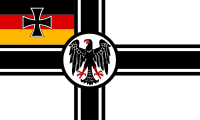Reichsmarine
| Reichsmarine (RM) | |
|---|---|
| Active | 1919–1935 |
| Country |
|
| Type | Navy |
| Part of | Reichswehr |
| Insignia | |
| War Ensign (1933–1935) |  |
| War Ensign (1921–1933) |  |
| War Ensign (1919–1921) never used |  |
The Reichsmarine (German: [ˈʁaɪçs.maˌʁiːnə], Navy of the Realm) was the name of the German Navy during the Weimar Republic and first two years of Nazi Germany. It was the naval branch of the Reichswehr, existing from 1919 to 1935. In 1935, it became known as the Kriegsmarine, a branch of the Wehrmacht; a change implemented by Adolf Hitler. Many of the administrative and organizational tenets of the Reichsmarine were then carried over into the organization of the Kriegsmarine.
The Vorläufige Reichsmarine (Provisional Imperial Navy) was formed after the end of World War I from the Kaiserliche Marine.
The provisions of the Treaty of Versailles restricted the German Navy to 15,000 men and no submarines, while the fleet was limited to six pre-dreadnought battleships, six cruisers, twelve destroyers, and twelve torpedo boats. Replacements for the outdated battleships were restricted to a maximum size of 10,000 tons.
The Reichsmarine was considered the armed naval force of the Reichswehrministerium (Reich War Ministry which was headed by a civilian minister appointed by the government of the Weimar Republic. The senior most naval officer was known until 1920 as the Chef der Admiralität (Chief of the Admiralty), after which the title changed to the Chief of the Naval Command (Chef der Marineleitung).
The naval commander oversaw a headquarters office known as the Marinekommandiertenabteilung which was headquartered in Berlin. The Naval Command also maintained a headquarters signal office (Marinenachrichtenoffizier) and a naval archives. Internal to the naval headquarters five offices known as the:
...
Wikipedia
